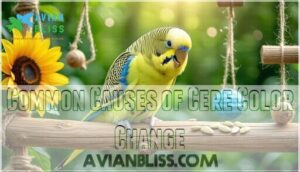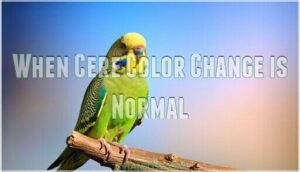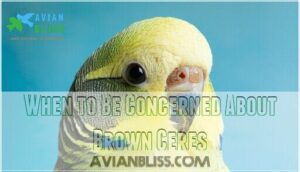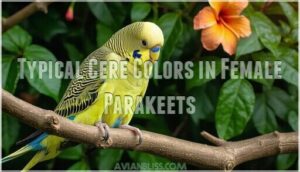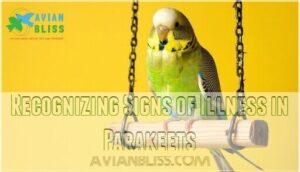This site is supported by our readers. We may earn a commission, at no cost to you, if you purchase through links.

However, if you’ve got a male bird sporting a brown cere, that’s a different story. Males should maintain blue ceres, so brown coloration often signals hormonal imbalances from conditions like Sertoli cell tumors or liver disease. Poor nutrition, particularly iodine deficiency, can also trigger this color change in both sexes.
Environmental stress doesn’t help either. The key is knowing your bird’s normal patterns and watching for additional symptoms like lethargy or appetite changes that might indicate something more serious brewing beneath the surface.
Table Of Contents
- Key Takeaways
- Why is My Parakeet’s Cere Turning Brown?
- Male Vs. Female Cere Color Differences
- Hormones and Health: The Science Behind Cere Color
- Diet and Environment Impact on Cere Health
- Recognizing Signs of Illness in Parakeets
- Steps to Take When Noticing Brown Cere
- Frequently Asked Questions (FAQs)
- Why is my parakeets nose turning brown?
- Can a parakeet’s cere change color?
- What does it mean when your parakeet’s beak changes color?
- Why is my parakeets poop brown?
- Can a parakeets cere turn brown due to stress?
- How often should I check my parakeets cere color?
- Can a brown cere be a sign of old age?
- Will a parakeets cere color change during molting season?
- Can parakeet cere color indicate breeding readiness?
- Do different parakeet species have varying cere colors?
- Conclusion
Key Takeaways
- Female parakeets develop brown ceres naturally during breeding season – this hormonal change is completely normal and will reverse after breeding ends, so don’t worry if you’ve got a female bird showing this coloration.
- Male parakeets with brown ceres need immediate vet attention – healthy males should maintain bright blue ceres, so brown coloring often signals serious hormonal imbalances from tumors or liver disease that require professional diagnosis.
- Poor nutrition and environmental stress can trigger cere color changes in both sexes – ensure you’re providing a balanced pellet-based diet with fresh vegetables and maintaining a clean, well-lit cage to prevent hormone disruption.
- Watch for additional symptoms beyond cere color changes – if your bird shows lethargy, appetite loss, breathing difficulties, or behavioral changes alongside the brown cere, seek emergency veterinary care immediately.
Why is My Parakeet’s Cere Turning Brown?
You’ve noticed your parakeet’s cere changing from its usual bright blue or pink to an unexpected brown color. This color shift can signal normal hormonal changes, breeding conditions, or underlying health issues that require your attention.
Common Causes of Cere Color Change
When your parakeet’s cere shifts color, you’re witnessing complex biological processes at work. Several factors can trigger these changes, affecting your bird’s health and appearance.
- Hormone Imbalance – Estrogen spikes can darken male ceres from blue to brown
- Nutrition Deficiency – Poor diet lacking essential vitamins affects cere pigmentation
- Environmental Factors – Stress, lighting, and cage conditions influence color changes
- Genetic Predisposition – Some parakeets naturally develop darker ceres with age
- Health Conditions – Tumors and infections cause abnormal cere coloration patterns
When Cere Color Change is Normal
Your parakeet’s cere might shift colors naturally during key life phases. Normal cere color variations occur during Parakeet Development around one year old, when birds shift from juvenile to adult coloring.
| Age/Phase | Normal Colors | Natural Causes |
|---|---|---|
| Juvenile | Pink/purple | Immature development |
| Young adult | Blue (males) | Sexual maturity |
| Breeding female | Brown/tan | Hormonal changes |
| Post-breeding | White/blue | Seasonal shifts |
| Normal Molting | Temporary changes | Feather regeneration |
Female parakeets commonly experience brown cere during breeding condition, then revert to lighter colors afterward. This cycling is perfectly healthy behavior linked to reproductive hormones. Males usually maintain consistent blue coloring unless health issues arise.
When to Be Concerned About Brown Ceres
When your pet bird’s cere suddenly shifts to brown, it’s time to sound the alarm bells. This dramatic Cere Color Change signals potential Parakeet Health Issues requiring immediate attention.
Unlike normal hormonal shifts, persistent brown ceres in males often indicate serious conditions like tumors or nutritional deficiencies. Watch for accompanying signs like changes in Parakeet Behavior, poor Feather Conditions, or decreased appetite. Don’t wait—consult an avian vet immediately.
Male Vs. Female Cere Color Differences
You’ll notice that healthy male parakeets generally show bright blue ceres, while females display brown, tan, or white ceres that can change with their breeding cycle.
Understanding these normal color patterns helps you spot when your bird’s brown cere signals a health problem rather than natural variation.
Typical Cere Colors in Male Parakeets
Healthy male parakeets display vibrant blue ceres that signal reproductive maturity. This distinctive Cere Color Genetics feature helps with Sexing Parakeets accurately. Male Parakeet Hormones maintain this blue coloration throughout most of their lives.
| Age Stage | Typical Cere Color | Hormonal Status |
|---|---|---|
| Juvenile (0-4 months) | Pink/Purple | Pre-sexual maturity |
| Young Adult (4-12 months) | Light Blue | Developing hormones |
| Mature Adult (1+ years) | Bright Blue | Full testosterone levels |
| Breeding Season | Deep Blue | Peak hormone activity |
Understanding Melopsittacus undulatus biology helps you monitor your parakeet’s health effectively.
Typical Cere Colors in Female Parakeets
Unlike males with their bright blues, female parakeets showcase earthy tones that tell their own story. Female Cere Colors range from light brown to deep chocolate, shifting with Parakeet Hormones and breeding cycles. Understanding these natural variations helps you monitor your budgie’s Beak Health and overall Parakeet Care needs effectively.
| Age Range | Typical Cere Color | Breeding Status |
|---|---|---|
| Young (0-4 months) | Pale pink/white | Immature |
| Adult (4+ months) | Light tan/brown | Non-breeding |
| Breeding condition | Dark brown/crusty | Active breeding |
| Post-breeding | Medium brown | Recovery phase |
| Senior (5+ years) | Variable brown | Age-related |
Watch for texture changes alongside color—healthy females maintain smooth ceres during normal Parakeet Behavior and Training sessions.
Breeding Condition Changes in Females
When your female parakeet’s ready to breed, her cere transforms dramatically. Female hormones surge during breeding cycles, turning her cere brown and crusty. This signals she’s primed for egg laying and nesting behavior.
| Breeding Stage | Cere Color | Physical Changes |
|---|---|---|
| Non-breeding | Tan/white | Smooth texture |
| Pre-breeding | Light brown | Slightly raised |
| Active breeding | Dark brown | Crusty, thick |
| Egg laying | Deep brown | Rough, flaky |
| Post-breeding | Lightens | Returns to smooth |
This natural cycle repeats throughout breeding season, affecting your pet bird’s overall female health and parakeet care needs.
Hormones and Health: The Science Behind Cere Color
Your parakeet’s cere color isn’t just cosmetic—it’s a window into their hormonal health that can reveal serious medical issues.
When a male’s bright blue cere suddenly turns brown, excess estrogen from conditions like Sertoli cell tumors is often the culprit, basically feminizing your bird’s appearance and signaling potential reproductive system problems.
Hormonal Influences on Cere Color
Your bird’s endocrine system controls cere pigmentation through hormone balance. Testosterone role in males keeps ceres blue, while rising estrogen levels trigger brown changes. This hormonal shift affects cere appearance dramatically.
Your parakeet’s diet and nutrition influence these hormone fluctuations. Pet bird health depends on understanding how the endocrine system regulates these color transformations in your feathered friend.
Sertoli Cell Tumors and Estrogen Imbalance
Sertoli cell tumors represent a serious health threat for male parakeets. These tumors secrete excess estrogen, disrupting normal hormone balance and causing your bird’s blue cere to turn brown or pink. Pet Bird Health specialists use Hormone Testing for accurate Tumor Diagnosis in Avian Oncology cases.
Sertoli cell tumors in male parakeets disrupt hormones, turning healthy blue ceres brown and signaling serious health threats
The symptoms of Sertoli cell tumors can be understood through testicular tumor research. Key warning signs include:
- Cere color changing from blue to brown/pink
- Lethargy and reduced appetite
- Abdominal swelling or distension
Cell Research shows these tumors affect 20-30% of cases involving feminization symptoms in parakeets.
Other Medical Causes of Brown Cere
Beyond tumor growth, several health issues can trigger hormone imbalance in your parakeet. Liver disease disrupts hormone processing, while kidney problems affect waste elimination. Infection risks from bacterial or fungal sources strain your bird’s system.
Nutrient deficiencies weaken immune response, making parakeets vulnerable. Genetic factors may predispose certain birds to these conditions.
Regular Bird Care Tips and proper pet care prevent many underlying health issues.
Diet and Environment Impact on Cere Health
Your parakeet’s diet and environment play vital roles in maintaining healthy cere color. Poor nutrition can trigger brown discoloration even in healthy males.
A dirty cage, inadequate lighting, or vitamin deficiencies create stress that affects hormone balance and cere appearance.
Nutritional Deficiencies and Cere Appearance
Poor feeding habits wreck your parakeet’s cere health faster than you’d think. Iodine deficiency turns male ceres purple-brown, while vitamin A shortage creates rough, scaly surfaces.
All-seed diets lack essential nutrients, making pellets and dietary variety vital. Mineral deficiency weakens cere structure, but vitamin supplements and proper parakeet nutrition restore healthy appearance.
Nutrient balance prevents most cere problems. A well-planned parakeet health approach is essential for maintaining a healthy cere.
Environmental Stressors Affecting Cere Color
Stress can trigger dramatic cere color shifts that catch you off guard. Your parakeet’s environment plays a bigger role than you’d think in maintaining healthy cere appearance:
- Light Exposure levels that are too bright or dim
- Air Quality issues from dust, smoke, or aerosols
- Noise Pollution from loud music or construction
- Social Stress from overcrowding or territorial disputes
- Cage Sanitation problems creating bacterial growth
These environmental stressors directly impact parakeet behavior and can cause physical changes.
Importance of Cleanliness and Cage Setup
A dirty cage creates the perfect breeding ground for bacteria that can irritate your pet’s cere. Your Cage Setup matters too – cramped cage bars restrict airflow, while proper Perch Arrangement prevents waste buildup.
Follow basic Cage Cleaning Tips: scrub weekly, provide Bird Bathing opportunities, and rotate toys regularly. Smart Toy Rotation keeps your safe area fresh. Skip Nesting Boxes unless breeding – they trigger hormonal changes.
Recognizing Signs of Illness in Parakeets
You’ll need to watch for additional symptoms beyond cere color changes to get the full picture of your bird’s health status.
A brown cere paired with lethargy, changes in appetite, or unusual breathing patterns signals it’s time for an immediate vet visit.
Additional Symptoms to Watch For
When your parakeet’s cere changes, watch for these red flags that signal trouble beyond color shifts. Behavioral Changes like increased aggression or lethargy often accompany hormonal imbalances. Weight Loss paired with a brown cere suggests serious illness requiring immediate attention.
- Feather Plucking around the head and neck area
- Respiratory Issues including labored breathing or wheezing sounds
- Beak Grinding becoming excessive or accompanied by head shaking
How to Assess Your Parakeet’s Overall Health
Checking your bird’s health goes beyond cere color. Look for bright, alert eyes and smooth feathers that aren’t ruffled constantly. A healthy parakeet maintains good posture and shows interest in its surroundings.
Monitor eating habits and droppings consistency. Regular Parakeet Checkups help catch issues early. Watch Feather Condition and Beak Health closely.
Proper Nutrition Advice promotes overall wellness alongside daily Socialization Tips for mental health.
When Cere Color Signals a Medical Emergency
Rapid Cere Color Changes combined with lethargy, difficulty breathing, or loss of appetite signal serious Medical Emergency Signs.
Your parakeet needs immediate veterinary care if brown Beak Color Signals appear alongside fluffed Feather Condition Indicators or sitting on the cage floor.
These Parakeet Health Risks require urgent attention – don’t wait until morning when your bird shows these warning signs.
Steps to Take When Noticing Brown Cere
When you notice your parakeet’s cere turning brown, don’t panic—but don’t ignore it either.
Quick action and proper veterinary assessment can help identify whether this change signals a normal hormonal shift or requires medical attention.
Immediate Actions for Concerned Owners
First things first – don’t panic when you spot that brown cere. Monitor your parakeet’s behavior closely for changes in appetite, activity, or droppings. Document what you observe for Emergency Care situations.
Contact an avian vet immediately for Health Checks and Vet Consultations. Meanwhile, make sure your parakeet’s diet remains consistent and nutritious.
Quick Behavior Monitoring helps determine if this needs urgent Parakeet Care and Maintenance intervention.
How to Prepare for a Vet Visit
Document everything before your Emergency Care visit. Write down recent Bird Behavior changes, diet shifts, and when the brown cere first appeared. Take clear photos of your parakeet’s cere from multiple angles.
Gather your pet’s Medical History, including previous Health Checks and treatments. This Vet Visit Prep helps guarantee thorough Parakeet Care and Maintenance while maximizing Pet Safety during birds examinations.
Preventative Measures for Cere Health
After preparing for your vet visit, focus on prevention to keep your parakeet’s cere healthy. Smart prevention beats costly treatment every time.
Here’s your prevention playbook:
- Nutrition Tips: Feed high-quality pellet diet with fresh vegetables daily
- Environmental Checks: Maintain clean cage with proper ventilation and lighting
- Cere Cleaning: Monitor beak care and feather health through gentle weekly inspections
Regular parakeet diet monitoring prevents hormonal imbalances that cause brown cere changes.
Frequently Asked Questions (FAQs)
Why is my parakeets nose turning brown?
Like nature’s warning bell, your parakeet’s nose turning brown often signals hormonal imbalance. Excess estrogen production, sometimes from tumors, causes this cere color change.
An avian vet visit can reveal the truth behind this transformation.
Can a parakeet’s cere change color?
Yes, your parakeet’s cere can definitely change color. It’s totally normal for males to shift from blue to brown due to hormonal changes, age, or health conditions like tumors.
What does it mean when your parakeet’s beak changes color?
Your feathered friend’s beak shifts color naturally through aging, diet changes, or illness.
Changes can signal malnutrition, fungus, injury, or bruising. Watch for unusual darkening or browning—it might indicate health issues requiring veterinary attention immediately.
Why is my parakeets poop brown?
Brown poop in your parakeet could signal dietary changes or health issues. Pellet-eating birds usually produce brown droppings, while seed-eaters produce green ones.
If it’s sudden or dark, consult your vet immediately.
Can a parakeets cere turn brown due to stress?
Don’t beat around the bush—stress can contribute to cere color changes in your parakeet.
Stress or health issues might alter this hue, turning it brown, though hormonal imbalances or tumors are more common causes.
How often should I check my parakeets cere color?
Check your parakeet’s cere weekly during routine health observations. Daily glances help you spot sudden changes early.
Weekly detailed inspections let you track gradual shifts that might signal health issues requiring veterinary attention.
Can a brown cere be a sign of old age?
Age itself isn’t the culprit behind brown ceres. Adult males develop dark blue ceres around 6-8 months, while female budgies’ ceres only turn brown during breeding season.
If you’re seeing brown in males, it’s hormonal issues or health concerns—not natural aging.
Will a parakeets cere color change during molting season?
Unlike permanent color changes, your parakeet’s cere won’t shift colors during molting season.
Hormonal fluctuations during breeding cycles cause cere changes, not the molting process itself. You’ll see feather renewal, but cere color stays consistent throughout molting.
Can parakeet cere color indicate breeding readiness?
Yes, cere color changes absolutely signal breeding readiness in parakeets. Mature females develop brown, crusty ceres when they’re ready to breed. Males maintain bright blue ceres year-round once mature.
Do different parakeet species have varying cere colors?
Different parakeet species definitely display unique cere colors. Budgerigars, for example, show blue in males and brown in females.
Males usually have light to dark blue ceres, but mutations display periwinkle, lavender, or pink colors.
Conclusion
Think of your parakeet’s cere as nature’s mood ring – it tells a story about what’s happening inside. When you notice your parakeet cere turning brown, don’t panic, but do pay attention.
Female birds often develop brown ceres during breeding season, which is perfectly normal. Males with brown ceres need veterinary attention since this usually signals hormonal imbalances or health issues.
Quick action, proper nutrition, and regular vet checkups keep your feathered friend healthy and happy.
- https://www.talkbudgies.com/threads/worried-about-my-male-budgies-cere-turning-brown.408006/
- https://www.reddit.com/r/budgies/comments/1aqrdnr/male_budgie_changing_cere_color_cause_of_concern/
- https://www.bucktons.co.uk/happyandhealthytogether/small-medium-bird-care/health-wellbeing-for-your-bird/
- https://lafeber.com/pet-birds/questions/parakeet-sexing/
- https://www.parrotforums.com/threads/help-my-male-budgies-cere-has-gotten-dark-is-this-normal.101298/

